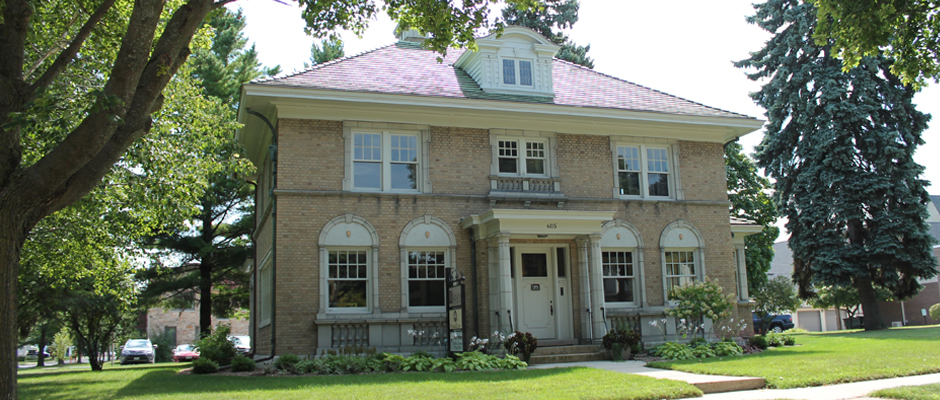Craftsmen Use Traditional Techniques, Materials to Restore Prange Home
Schultz, Deanne The Sheboygan Press, January 17, 2015, page A1.
They don't make 'em like they used to.
That's what Jennifer Lehrke, owner of Legacy Architecture in Sheboygan, found when she bought the stately Mediterranean-style brick mansion at 605 Erie Avenue late last year.
The house, built by Eliza Prange in 1923, was used by St. Mark Lutheran Church as its parsonage until 1998. Since then it had sat empty and the Board of Trustees at St. Mark knew they had a win-win situation on their hands when they sold it to Lehrke last year.
"When I walked in here and saw the beautiful crown molding and leaded glass doors, I said 'Oh, yeah,'" Lehrke recalled.
Quite possibly the most critical update was the refurbishment of the clay tile roof. Lehrke hired Van De Hey Refined Roofing, LLC, from DePere for the job, which she expected to take between two to three weeks to complete.
Owner Chris Van De Hey began by evaluating the quality of the existing tiles, discarding a small percentage of bad ones, and purchasing salvaged tiles to match.
Looking long-term
"In this case, the tile can last many more years," he said. "After replacing the underlayment and copper flashing, we reinstall the salvaged tile and trim, (using) copper nails."
Van De Hey's team also installed copper gutters with soldered seams, along with copper flashing on the home's two chimneys, valley and dormer.
Using asphalt shingles would have cut costs almost in half, but Lehrke knew that wasn't the way to go.
"It's the initial cost versus long-term," she said. "We're using tax credits for this building, and they would have allowed us to put an asphalt shingle roof up there, but it wouldn't have looked the same."
The home is on the National Register of Historic Places. The National Park Service, which oversees the National Register, considers 605 Erie a certified rehabilitation. Through their program of Historic Preservation Tax Incentives, Lehrke is receiving a 20 percent tax credit.
"For instance, if you spend $100,000 on rehabbing the building, you would be eligible for $20,000 in federal tax credits and $20,000 in state tax credits," she said. "This isn't a tax credit like most taxpayers would think - you don't get two $20,000 checks in April."
Rather, she said it cancels out your tax liability, and credits can be carried over until they are used up, or for up to 20 years.
Old school methods
Inside the house, the tang of fresh paint wafted in the air, along with the rhythmic crackle of paint rollers gliding up and down the walls. After workers removed small sections of plaster to install a modern electrical system, they discovered evidence that Eliza had chosen gold paint for the walls; Lehrke is also painting the walls a subtle shade of gold to honor this.
In Eliza's former living room, plaster was applied to the walls in a pattern that closely mimicked the original coat. Tax credit use dictates that wall colors and textures match as closely as possible, and since Eliza chose plaster for the original walls, Lehrke followed suit.
Plaster also gives the walls additional strength, along with lending itself to the creative process, according to Derek Strande, an employee of Steve Tenpas Drywall, who was working on the walls.
"There are different designs we can do with plaster than with drywall," Strande said. "With drywall, you're limited to a spray texture. With plaster, you can do a lot of hand textures. Plaster is back to the old school, all hand-troweled."
Old-school methods are also being used by Scott Thiel Construction, which is responsible for restoring the impressive leaded-glass doors that led to Eliza's sun porch, soon to be Lehrke's new office.
Rain from a leaking roof seeped down, damaging the doors.
Thiel, owner of the company, said restoring the doors challenges his workers' skills. They need to almost step back in time, honoring Eliza's intentions as they create new doors that duplicate her originals, he said.
"We have to take that piece and remake it to match precisely in species of wood, exact detail and finish color," he said. "This experience is truly exciting."
Online
Do you think your home is worthy of inclusion on the State or National Register of Historic Places. Go online to www.wisconsinhistory.org to learn whether your house is on the list and to learn more about the process of registering it.
Lehrke said it takes a significant amount of time to complete all the paperwork. She recommends hiring a consultant with experience to guide owners through the process. Consultant costs are covered by the tax credits. For more information on tax credits go online to visit alturl.com/wwi6v.

